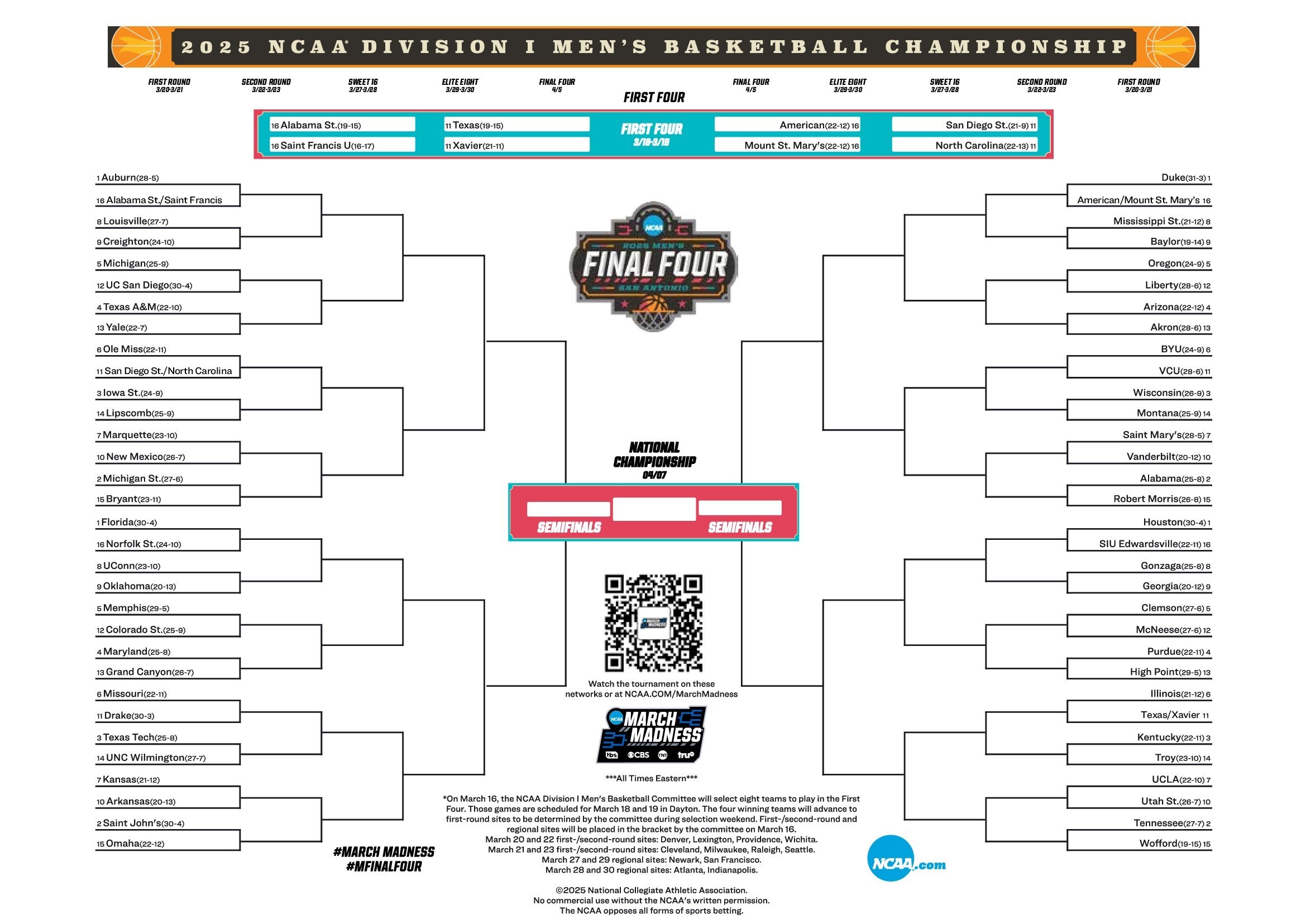March Madness Is Upon Us
Hear it here!
It all started with the traditional Selection Sunday when the 68-team field was revealed.
Who made it. Who didn’t. Who are the #1 seeded teams. Who plays whom and where do they play? It begins with a pair of play-in games Tuesday and Wednesday before the action involving 64 schools begins Thursday, capped with the Final Four in the first week of April.
The Sunday show featured analysis, over-analysis, intense questions over why some teams like North Carolina got in, and some, such as West Virginia did not.
It’s the same every year, but it’s different because they’re always talking about different schools.
This year, the number one seeds are Auburn, Duke, Houston and Florida. No one has a problem with that.
It’s all pretty exciting, and it’s a wonderful time of the year in sports. Many of those who watch have their own group of people where you fill in your brackets and hope for the best. By the way, the odds of picking all 63 games correctly are 1 in 9.2 quintillion.
That seems tough to do. Just sayin’.
As the games begin, there will be buzzer-beaters, shocking upsets, and matchups involving great coaches who have great reputations.
When the Final Four comes around, after all the craziness, you will find that most of the teams still standing come from among the top four seeds in each region.
Once upon a time, in a different life, there were 24 and 25 teams in the tournament.
The regions were named East, Southeast, Midwest, and West. Schools from those areas only played where they came from until the Final Four. Now, they mix it up and with so many in the field, you find St.John’s playing the first two rounds in Providence in the West Region. Go figure. If a conference, say the Atlantic Coast, had five teams represented it was a big story. This year, the Southeastern Conference has 14.
Many of them may have a losing record in conference play, but they have been dominant playing teams from outside the conference. That’s where they will start when the ball gets rolling.
I have no idea who will win, make the Final Four, or advance deep into the tournament.
It’s the old story, it’s not the better team that wins, but who plays better that day.
As a broadcaster, this was one of the thrilling and grueling weeks of the year.
I would watch the Sunday show, learn pairings, then wait for the call later that night to find out my assignment. Then the fun would begin. If I had a Thursday, Saturday region, I had to request plane reservations quickly, leaving on Tuesday. If I were assigned to a Friday and Sunday matchup I had the luxury of an extra day to prepare and get things done.
Monday and Tuesday before departure, I would do a deep dive into the 8 teams I would be covering. I would have to learn about some obscure schools in those days. The information wasn’t that easy to find.
Wednesday and Thursday are the toughest days for any announcer covering the NCAA Championship. My day would start at 9am and finish at 9pm. Eight schools would have practice sessions, followed by a news conference by the head coach. I would jump from the court to a back room at the arena to watch the players and hear the coach, then return to the court for when the next team took the floor. Preparation for these games were all about getting an understanding in rapid fashion, not only who the players were and how they performed on the court, but human interest stories about them and the school in general as to their history in the sport. A lot to do in a short period of time.
Practice was critical, not so much as learning how a team played, but who the players were. Put a number with a name. If they had names on the backs of their practice uniforms so much the better. But many of the smaller and far less prominent schools did not. We always joked between us that we hoped we didn’t get a “directional” school such as SE Louisiana, or NE Missouri State, which often had no names on their uniforms.
Don’t get me wrong. We’re not talking about grueling and frenzied work like in the construction field or anything serious. This was fun stuff. Actually, I never called what I did work.
Our crew would meet after the full day of action and coaches’ interviews and go over each of the four games upcoming the next day. There would be no time available the next morning when the production crew would have to get to the arena early and do what they had to do.
The next day was upon us and we would broadcast four games, starting around noon with a doubleheader. Following a break of about two hours we’d be at it again with the final two games starting at 7pm and ending around 11pm.
So those two days, the practice sessions, the head coach interviews, and the four games of the first round were the biggest challenge any of us faced.
The next day was an abbreviated version of the first practice day. Now there were four teams to cover and coaches’ interviews dealing with the upcoming second round contests. The following day the two second round games were played.
Week two of March Madness was not as furious to cover with the four teams in the Sweet 16 and then Elite Eght round involved.
So, following a doubleheader on either Thursday or Friday and a regional final on Saturday or Sunday, one of the Final Four entries would be established.
I’ve gone into detail on the prep for the first two weeks to indicate how much time and effort the broadcasters spend as you, the viewer, go back and forth using your remote to relax and enjoy the great action while sitting on your ottoman.
Often my assignment for the second week would involve a totally different region so it became necessary to learn four new teams from the first week of play.
One year, I was teamed with the legendary analyst Billy Packer for the first round while the lead play-by-play announcer, Jim Nantz handled the studio coverage, which he did so well. He would join Billy the second week and I would be given a different partner.
We were assigned a Thursday night game in Salt Lake City, Utah, then traveled by private plane to Baton Rouge, Louisiana the next morning for a doubleheader to be played Saturday, only to board another private flight to Minneapolis early on Sunday to broadcast two games that same day. How hectic do you think that was?
Five games in four days in three cities, none close to the other.
These experiences are what I remember more than the games I broadcast.
I can hardly remember them all or most of them because there were so many and they become a blur. I even covered many tournament games involving Syracuse, my Alma Mater.
Readers may wonder how difficult it was not to root for the Orange, or did I really become a big fan?
The answer is simple. There were so many facts to be aware of for both schools, and the demand to concentrate intently on the action to make sure the calls were correct, that it was impossible to sit back and root for your school, even though I naturally wanted them to win.
So, March Madness is here and it’s one big circus of competition involving drama, surprises, and wonderful stories of the people involved.
It all winds up with a national championship for someone. The nets get cut down after the final game and there are memories galore for so many.
For those who broadcast the games, the term March Madness couldn’t be a better way to sum it all up.


